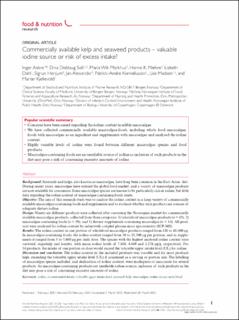| dc.contributor.author | Aakre, Inger | |
| dc.contributor.author | Solli, Dina Doblaug | |
| dc.contributor.author | Markhus, Maria Wik | |
| dc.contributor.author | Mæhre, Hanne K | |
| dc.contributor.author | Dahl, Lisbeth | |
| dc.contributor.author | Henjum, Sigrun | |
| dc.contributor.author | Alexander, Jan | |
| dc.contributor.author | Korneliussen, Patrick-Andre | |
| dc.contributor.author | Madsen, Lise | |
| dc.contributor.author | Kjellevold, Marian | |
| dc.date.accessioned | 2021-05-19T13:02:11Z | |
| dc.date.available | 2021-05-19T13:02:11Z | |
| dc.date.created | 2021-04-16T10:27:32Z | |
| dc.date.issued | 2021-03-30 | |
| dc.identifier.citation | Food & Nutrition Research. 2021, 65. | en_US |
| dc.identifier.issn | 1654-6628 | |
| dc.identifier.uri | https://hdl.handle.net/11250/2755714 | |
| dc.description.abstract | Background: Seaweeds and kelps, also known as macroalgae, have long been common in the East-Asian diet. During recent years, macroalgae have entered the global food market, and a variety of macroalgae products are now available for consumers. Some macroalgae species are known to be particularly rich in iodine, but little data regarding the iodine content of macroalgae-containing foods exists. Objective: The aim of this research study was to analyse the iodine content in a large variety of commercially available macroalgae-containing foods and supplements and to evaluate whether such products are sources of adequate dietary iodine. Design: Ninety-six different products were collected after surveying the Norwegian market for commercially available macroalgae products, collected from three categories: 1) wholefood macroalgae products (n = 43), 2) macroalgae-containing foods (n = 39), and 3) dietary supplements containing macroalgae (n = 14). All products were analysed for iodine content by inductively coupled plasma-mass spectrometry (ICP-MS). Results: The iodine content in one portion of wholefood macroalgae products ranged from 128 to 62,400 µg. In macroalgae-containing foods, the iodine content ranged from 30 to 25,300 µg per portion, and in supplements it ranged from 5 to 5,600 µg per daily dose. The species with the highest analysed iodine content were oarweed, sugarkelp and kombu, with mean iodine levels of 7,800, 4,469 and 2,276 µg/g, respectively. For 54 products, the intake of one portion or dose would exceed the tolerable upper intake level (UL) for iodine. Discussion and conclusion: The iodine content in the included products was variable and for most products high, exceeding the tolerable upper intake level (UL) if consumed as a serving or portion size. The labelling of macroalgae species included, and declaration of iodine content, were inadequate or inaccurate for several products. As macroalgae-containing products are unreliable iodine sources, inclusion of such products in the diet may pose a risk of consuming excessive amounts of iodine. | en_US |
| dc.description.sponsorship | This research study is financially supported by the Insti- tute of Marine Research. | en_US |
| dc.language.iso | eng | en_US |
| dc.publisher | Swedish Nutrition Foundation | en_US |
| dc.relation.ispartofseries | Food & Nutrition Research;volume 65 | |
| dc.rights | Navngivelse 4.0 Internasjonal | * |
| dc.rights.uri | http://creativecommons.org/licenses/by/4.0/deed.no | * |
| dc.subject | Iodine | en_US |
| dc.subject | Recommended intakes | en_US |
| dc.subject | Tolerable upper intake levels | en_US |
| dc.subject | Public health | en_US |
| dc.subject | Seaweeds | en_US |
| dc.subject | Kelps | en_US |
| dc.subject | Macro-algae | en_US |
| dc.title | Commercially available kelp and seaweed products – valuable iodine source or risk of excess intake? | en_US |
| dc.type | Peer reviewed | en_US |
| dc.type | Journal article | en_US |
| dc.description.version | publishedVersion | en_US |
| dc.rights.holder | Inger Aakre et al. | en_US |
| dc.source.articlenumber | 7584 | en_US |
| cristin.ispublished | true | |
| cristin.fulltext | original | |
| cristin.qualitycode | 1 | |
| dc.identifier.doi | http://dx.doi.org/10.29219/fnr.v65.7584 | |
| dc.identifier.cristin | 1904514 | |
| dc.source.journal | Food & Nutrition Research | en_US |
| dc.source.volume | 65 | en_US |
| dc.source.pagenumber | 17 | en_US |

